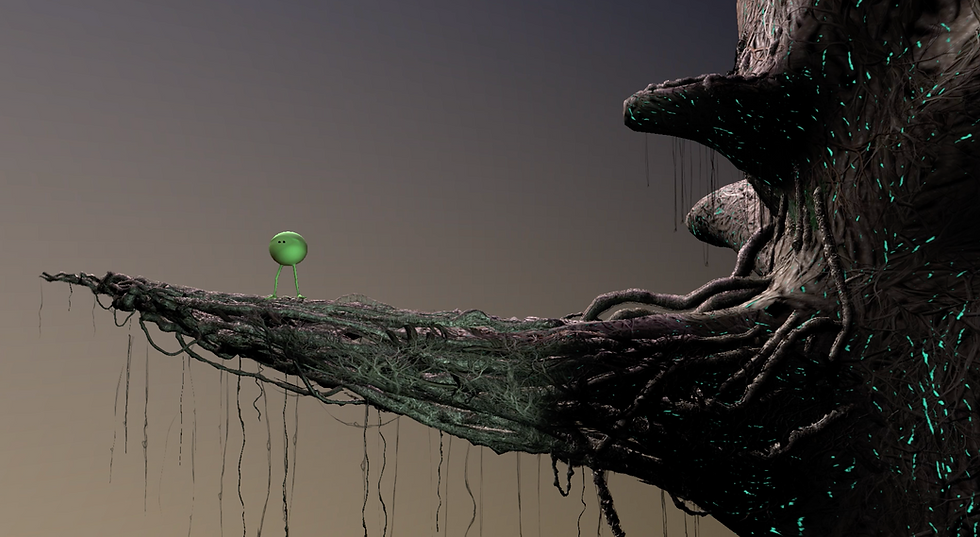Unit 5 : Dialogue with no mouth
- Briony Davies
- Jun 25
- 3 min read
Updated: Aug 21

In this unit, we are tasked with creating a dialogue scene featuring a character that lacks a mouth and has minimal facial features and controls. This challenge allows us to explore alternative methods and techniques for conveying dialogue through gestures and emotion. It is an excellent opportunity to communicate without relying on a mouth and to bring this simple rig to life by emphasizing the nuances of words or letters through visual cues.
After watching the tutorials, I began to consider what my shot will be, a method that is becoming more and more standard with every animation i've created in this module. I thought about what the specifc dialgue was, how that could be made into a narrative, and to make it believeable. Thinking about the shot repeatedly helps renforce my own direction and confidence in what i'm animating. I found audio from moviesoundclips which was simple enough for this short animation:
"Hello?...anyone out there?"
I then uploaded this audio into Maya by dragging it onto the time-slider, this helped in breaking down specific key frames.

I started by sketching thumbnails to identify which points would serve as the accents, with the accent being the point of greatest change. This allowed me to time the poses for anticipation, squash, stretch, overshoot, and then settle. I wanted the accent to happen on the "ll" part of hello, as that seems to have a lot of emphasis and volume; therefore, the anticipation would happen on the "he" part of hello. I then added another accent on "anyone," which will help create a bouncy gesture. I also planned to have this character look and search in its surroundings to fit in with the narrative, so the motion will transition from one side to the other and settle looking out beyond. I believe this will add some suspense and curiosity to the character.
The most difficult aspect of this exercise is expressing these gestures with a very basic rig. Having used this rig previously, I was familiar with its limitations, which are more stylistic than technical, since this character lacks arms but has detailed leg controls. This resulted in less animation work, saving time, but required focusing on a limited number of controls to convey the dialogue.
To further my understanding of emotions, I drew inspiration from Norman Rockwell, an American painter known for encapsulating storytelling within a single painting by using facial expressions to convey everything. One of my favorites, and among his most acclaimed works, is The Young Lady with the Shiner (1953). I sought inspiration from this piece to capture essential emotions, even if not fully achievable in this animation, but potentially in future ones.
Once I felt confident with the poses and timings, I began blocking by using my past experience from other projects. I keyed only the key poses to set the timing, then added the in-betweens. Since this animation is 60 frames long, it didn't take much time to block, add in-betweens, and refine, ensuring I captured every accent and dialogue accurately.
I concentrated on detailing the eyes and eyebrows, as this was the only way to express the emotions behind the words. Given the limited controls, it was essential to use precise and strong poses. This rig has been crucial in keeping things simple while mastering the basics and expanding upon them to craft a layered and emotionally impactful animation with such a simple rig.
I used a cliff model from TurboSquid and made some adjustments to it to help with playback and simplicity of this shot. I created a plane for the background and added a gradient to the texture to create a sky, as well as using lights to enhance the shot.
I'm pleased with the outcome and the principle from this exercise, which is to emphasise spoken words using body language and facial expressions. The most challenging part was planning and determining the timings and poses, as precision was essential for executing them accurately. To improve the experience, I would lengthen the lead-up to the shot, giving more time before the audio begins, enabling the audience to better grasp the context.
Bibliography -
Rockwell, N. (1953). The Young Lady with the Shiner. [Oil on Canvas] Available at: https://www.thewadsworth.org/highlight-rockwell/ [Accessed 23 Jun. 2025].


Comments